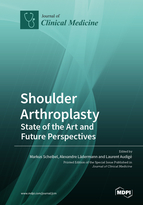Shoulder Arthroplasty: State of the Art and Future Perspectives
A special issue of Journal of Clinical Medicine (ISSN 2077-0383). This special issue belongs to the section "Orthopedics".
Deadline for manuscript submissions: closed (10 June 2022) | Viewed by 48243
Special Issue Editors
2. Department of Shoulder and Elbow Surgery, Center for Musculoskeletal Surgery, Charité-Universitaetsmedizin Berlin, Berlin, Germany
Interests: shoulder joint; scapula; shoulder dislocation; acromioclavicular joint instability; arthroscopic rotator cuff repair; arthroscopy
Special Issues, Collections and Topics in MDPI journals
Interests: shoulder surgery; reverse shoulder arthroplasty; prosthesis; glenohumeral stabilization; rotator cuff
2. Shoulder and Elbow Surgery Department, Schulthess Clinic, Zürich, Switzerland
3. Department of Orthopaedic Surgery and Traumatology, University Hospital of Basel, Basel, Switzerland
Interests: clinical epidemiology; register documentation; patient outcomes; surgical complications; prognostic studies; randomized trials; observational studies
Special Issue Information
Dear Colleagues,
Medical practice and the field of shoulder arthroplasty in particular are moving toward precision medicine. Patients expect not only pain alleviation but also recovery of function to allow independent execution of activities of daily living and return to sports. Novel implant designs, configurations, and combinations are constantly emerging, driven by high market demand in an increasingly aging population. However, direct comparison of implants and clinical outcomes is often challenging due to confounding by primary indication and clinical settings. Consequently, the field of shoulder joint replacement urgently requires additional studies on safety, patient satisfaction, cost-effectiveness, and optimal ways to maximize functional recovery and to minimize complications and revision rates. Among the pertinent practical open questions in reverse shoulder arthroplasty (RSA) are the benefits of lateralization and subscapularis refixation, optimal humeral inclination, and the usefulness of preoperative planning software. For anatomic arthroplasty, data are scarce on factors that can contribute to prevention and early detection of glenoid component loosening. The aim of this Special Issue, therefore, is to provide a stage for outstanding clinical, technical, and epidemiological contributions describing recent advances that can lead to improvements of diagnosis, treatment, and prognosis in shoulder arthroplasty.
Prof. Dr. Markus Scheibel
Dr. Alexandre Lädermann
Prof. Dr. Laurent Audigé
Guest Editors
Manuscript Submission Information
Manuscripts should be submitted online at www.mdpi.com by registering and logging in to this website. Once you are registered, click here to go to the submission form. Manuscripts can be submitted until the deadline. All submissions that pass pre-check are peer-reviewed. Accepted papers will be published continuously in the journal (as soon as accepted) and will be listed together on the special issue website. Research articles, review articles as well as short communications are invited. For planned papers, a title and short abstract (about 100 words) can be sent to the Editorial Office for announcement on this website.
Submitted manuscripts should not have been published previously, nor be under consideration for publication elsewhere (except conference proceedings papers). All manuscripts are thoroughly refereed through a single-blind peer-review process. A guide for authors and other relevant information for submission of manuscripts is available on the Instructions for Authors page. Journal of Clinical Medicine is an international peer-reviewed open access semimonthly journal published by MDPI.
Please visit the Instructions for Authors page before submitting a manuscript. The Article Processing Charge (APC) for publication in this open access journal is 2600 CHF (Swiss Francs). Submitted papers should be well formatted and use good English. Authors may use MDPI's English editing service prior to publication or during author revisions.
Keywords
- Reverse shoulder arthroplasty (RSA)
- Total shoulder arthroplasty (TSA)
- Hemiarthroplasty
- Rotator cuff arthropathy
- Osteoarthritis
- Proximal humeral fractures
- Complications
- Revisions
- Patient-reported outcomes








